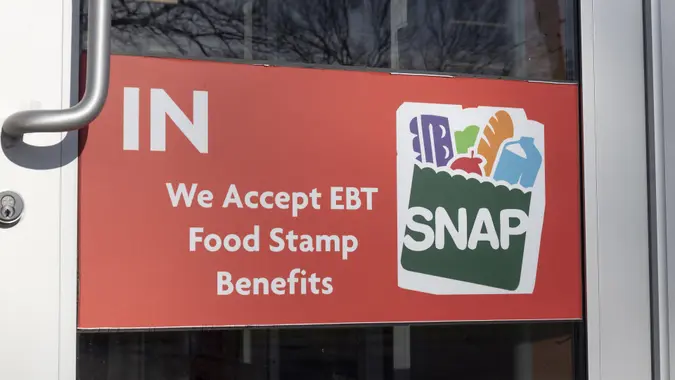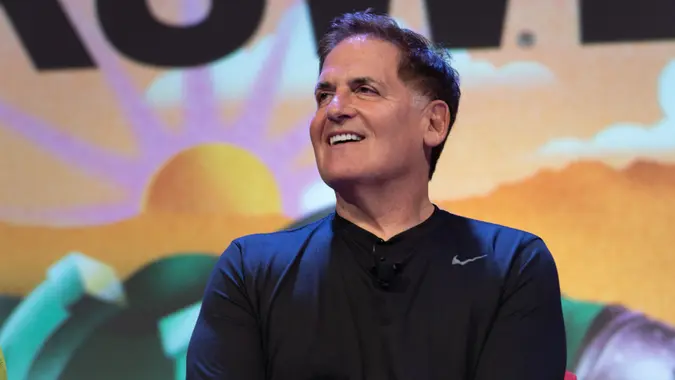High Interest Rates Aren’t Helping Bring Down Inflation, So Why Isn’t the Fed Offering Relief?

Commitment to Our Readers
GOBankingRates' editorial team is committed to bringing you unbiased reviews and information. We use data-driven methodologies to evaluate financial products and services - our reviews and ratings are not influenced by advertisers. You can read more about our editorial guidelines and our products and services review methodology.

20 Years
Helping You Live Richer

Reviewed
by Experts

Trusted by
Millions of Readers
Inflation has slowly been ticking down, standing at 3% in June 2024, down from 3.3% in May, according to the latest Consumer Price Index (CPI) data, released July 11.
While this is a sigh of relief for consumers, who have been affected by higher prices whether at the grocery store or because of higher rents and mortgages for quite some time, inflation is still taking a toll on finances and savings.
To put this in perspective, while inflation has come down from the record 9.1% it stood at two years ago in June 2022 (per CPI data), it is still a far cry from the Federal Reserve’s 2% target, as well as from where it stood in May 2020: 0.1%.
So it’s no surprise that the Fed has been reluctant to cut rates, and has revised earlier estimates (following its Federal Open Market Committee [FOMC] meeting) to one cut in 2024, down from the previous several cuts it had anticipated earlier in the year.
“While considerable progress has been made, inflation remains above the Fed’s target of 2%,” said Matt Colyar, economist, Moody’s Analytics. “Whereas the Bank of Canada [BoC] and European Central Bank [ECB] cut rates before their respective inflation targets were reached, the Fed has opted for a more cautious approach.”
According to Colyar, the U.S. economy’s recovery from the pandemic has been world-class, and while economies in peer countries have done better than expected, the U.S. really has navigated the post-pandemic world best.
“This has given the Fed cover to wait,” he added.
Too Premature To Cut Now
The next FOMC meeting will occur July 30-31, and odds are there will be no cuts then, according to experts.
According to Jeffrey A. Rosenkranz, Portfolio Manager of Shelton Capital Management, the Fed has not cut rates yet because doing so would have been premature.
Rosenkranz argued that if inflation becomes entrenched, it is much harder to extinguish, so the FOMC has had to err on the side of caution and hold rates higher for longer.
“In addition, because such a large percentage of existing mortgages were fixed at such low rates, the normal long and variable lags that monetary policy operates with look to be even longer this cycle, so the Fed has had to work harder and longer to influence behavior and take some of the air out of the economy and the labor market,” he added.
Still Being Cautious
Moody’s Colyar explained that while the BoC and ECB made their decisions to cut rates because they consider their current trend of disinflation to be sustainable, in the U.S. the first quarter of 2024 called that “a bit into question.”
“This is a key reason for the Fed’s more cautious approach,” he said. “Even after the first three months of inflation data came in hotter than expected, we opined that the forces pushing up monthly data — weird rent measurements, rising consumer healthcare prices and lagged increased in auto insurance premiums and repairs — were idiosyncratic and not reflective of on-the-ground inflationary pressure,” he added.
A good contrast, he noted, would be airfare, hotel rooms, car and grocery prices.
“Prices for these things respond quickly to demand pressures and an acceleration would indicate supply can’t keep up. For the rent/healthcare/insurance components, that is not the case,” added Colyar.
When Will They Cut Rates?
The consensus is for the Fed to start doing so in September, with 93.3% odds, according to the CME FedWatch Tool.
And as Colyar further noted, now that the Fed has seen three offsetting months of cooling inflation, “they are ready to cut,” with a first cut in September, then in December.
Several experts echoed the sentiment, also noting that economists expect more cuts in 2025.
“Overall, while inflation is trending downward, the Fed is maintaining a cautious approach to ensure sustainable progress toward its 2% target,” said Sean Bonner, Head of Strategic Initiatives at Siebert Financial, adding that the labor market and the policies of a new administration make it very hard to predict when inflation gets back to the 2% target.
“The Fed has stated it will be data dependent, meaning they will let economic indicators drive interest policy,” said Bonner. “This is important because the Fed and the Treasury ignored data in 2021 which in part caused the unprecedented rise in inflation.”
 Written by
Written by  Edited by
Edited by 

























